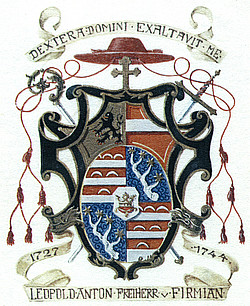
Schloss Leopoldskron was commissioned as a family estate in 1736 by the Prince Archbishop of Salzburg, Leopold Anton Freiherr von Firmian (1679-1744). The Scottish Benedictine monk, Bernhard Stuart, is regarded as Leopoldskron's master builder. In addition, Johann Kleber's stucco work on the ceilings throughout the Schloss is described as “the best example of rococo stucco the land can offer”.
Leopold Firmian was a great lover of science and the arts, but is most remembered for his role in the expulsion of more than 22,000 Protestants from the Archbishopric of Salzburg. Leopold’s harsh actions were noticed all over Europe and both Salzburg’s economy and the reputation of the Firmian family suffered severely as a result. The commission of Schloss Leopoldskron was, in part, an attempt by the Archbishop to rescue the social standing of his family.
A special law made the property a private possession of the family. In May 1744, Leopold deeded the completed Schloss over to his nephew, Count Laktanz Firmian. After his death later in the same year, the Archbishop’s body was buried in Salzburg’s cathedral, but his heart remains below the Chapel in the Schloss, which, as is inscribed on the chapel floor, he “loved so dearly.”
Count Laktanz, a collector of art and an artist himself, enriched Schloss Leopoldskron with the largest collection of paintings Salzburg had ever known, including works of artists such as Rembrandt, Rubens, Dürer, and Titian. The Count was one of the first sponsors of Leopold Mozart and his son, Wolfgang Amadeus.
When Laktanz died in 1786, his son started selling the famous paintings and Leopoldskron experienced a time of decline. In 1837, when it was sold to George Zierer, owner of a local shooting gallery, the collections were dismantled and most of the remaining valuable paintings, etchings, and sculptures were removed. During the 19th century the Schloss passed through various hands, among them Bavarian King Ludwig I and Carl Spängler, a well-known banker and two waiters who attempted to turn it into a hotel.
